![]()
![]()
![]()
Use LEFT and RIGHT arrow keys to navigate between flashcards;
Use UP and DOWN arrow keys to flip the card;
H to show hint;
A reads text to speech;
98 Cards in this Set
- Front
- Back
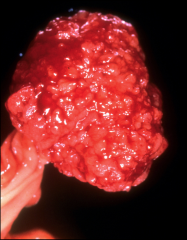
|
This benign neoplasm of the large intestine is referred to as a tubular adenoma or adematous polyp. |
|
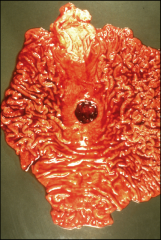
|
The pathologic defect (ulcer) in the wall of the stomach most likely represents peptic ulcer disease. This common condition is associated with chronic gastritis caused by Helicobacter pylori infection. |
|
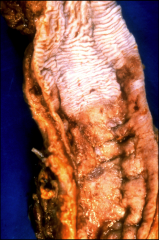
|
This is Barrett esophagus; shows replacement of squamous epithelium (top) by columnar secretory epithelium (bottom). Important risk factors for Barrett esophagus include smoking and alcoholism. |
|
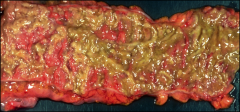
|
This inflammatory disease of the colon is associated with antibiotic therapy. The most likely diagnosis is pseudomembranous colitis. |
|
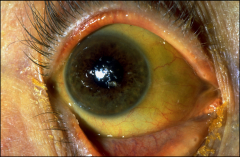
|
This patient in hepatic failure displays a yellow sclera because of increased production of bilirubin. Bilirubin is a natural breakdown product of hemoglobin turnover. |
|

|
The cut surface of this liver reveals the characteristic features of macronodular cirrhosis. Causes of cirrhosis include: alcoholism, hemochromatosis, and chronic viral hepatitis. |
|

|
This autopsy specimen reveals teh most common malignant neoplasm found in the liver, namely metastatic carcinoma. Note the "cannonball" metastases. Risk factors for liver cancer include chronic Hepatitis B and C infections. |
|

|
These proliferating cells in the brain appear in response to chronic injury (in this case syphilis). They are identified morphologically as astrocytes (like little stars). |
|

|
This gall bladder has been opened to reveal numerous, small, dark stones composed primarily of bilirubin plus calcium. Bilirubin is a natural breakdown product of hemoglobin turnover. |
|

|
Endocrine secretion from this pancreatic endocrine (islet cell) tumor leads to hypoglycemia. The diagnosis is insulinoma. |
|

|
This kidney was removed at autopsy of a 48-year old woman with an autosomal dominant genetic mutation. The most appropriate diagnosis is adult polycystic kidney disease. |
|
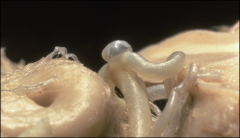
|
This berry aneurysm in the brain is a consequence of a developmental error (congenital birth defect). |
|
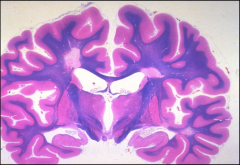
|
This coronal section of the brain was stained for myelin (blue-purple color). It reveals areas of demyelination (white plaques) that suggest a diagnosis of multiple sclerosis. |
|
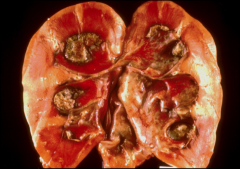
|
This condition is most common in elderly diabetics with severe cases of acute pyelonephritis, secondary to urinary tract obstruction. It is referred to as papillary necrosis because the tips of the renal papillae are dead tissue. |
|

|
Urinary tract obstruction can lead to dilation of the ureters, pelves, and calyces. The kidney on the right also shows severe atrophy. This pathologic condition is termed hydronephrosis. |
|
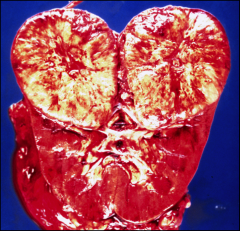
|
This malignant tumor was removed from the left kidney of a 40-year old woman. The most likely diagnosis is renal cell carcinoma. |
|
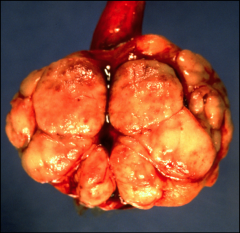
|
Seminomas are testicular cancers that are sensitive to radiation and account for half of all male germ cell tumors. |
|
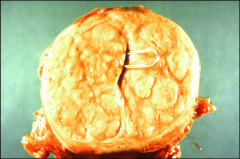
|
This common prostrate disorder causes decreased vigor of the urinary stream and increased urgency and frequency. The most appropriate diagnosis is nodular prostatic hyperplasia. |
|
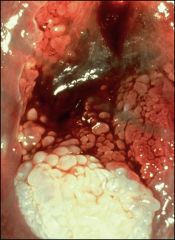
|
Human papilloma virus (HPV) can cause lesions of the uterine cervix. HPV is believed to be involved in the pathogeneis of cervical cancer. |
|
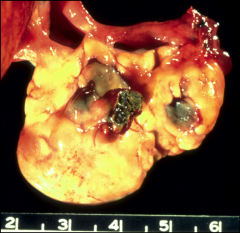
|
Half of all women with dysmenorrhea (difficult and painful menstruation) have these "mulberry" nodules on their ovaries, containing endometrial glands and stroma. The most appropriate diagnosis is endometriosis. Endometriosis can cause infertility. |
|
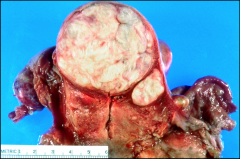
|
This benign tumor of the uterus is derived from a smooth muscle cell. It is termed leiomyoma. |
|
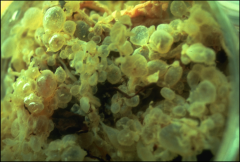
|
The malignant counterpart of this pregnancy-associated trophoblastic disease is called choriocarcinoma. It can be caused by fertilization of an empty egg with a normal sperm. |
|
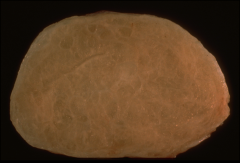
|
This benign tumor was removed from the left breast of a 23-year-old woman. The most likely diagnosis is fibroadenoma. |
|
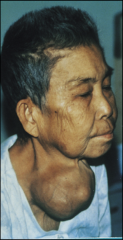
|
This patient has an enlarged thyroid that is NOT associated with functional, neoplastic or inflammatory alterations. The most likely diagnosis is goiter (also referred to as non-toxic goiter). |
|
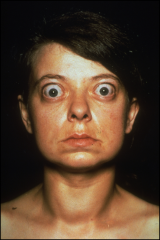
|
This patient with Graves disease suffers from bulging eyes, tachycardia, oligomenorrhea, nervousness and tremors. Blood analysis will reveal antibodies directed against the cell surface receptor thyroid stimulating hormone (TSH). |
|

|
The adrenal medulla is the most frequent site of origin for this malignant neoplasm of childhood. It is a neuroblastoma. It accounts for half of all cancers diagnosed in the first month of life. |
|
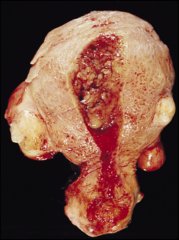
|
The pathogenesis of this uterine endometrial cancer is linked to prolonged stimulation with estrogen. |
|
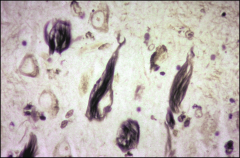
|
This histologic findings shown here are typically found in patients with Alzheimer disease. |
|
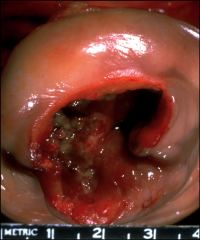
|
This ulcerated lesion of the uterine cervix was discovered in a 55-year old woman who presented with vaginal bleeding. The most likely diagnosis is squamous cell carcinoma (cervical cancer). |
|
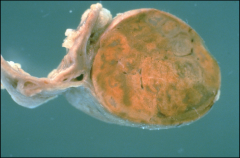
|
This adrenal adenoma was removed from a 50-year old woman with Cushing syndrome. |
|
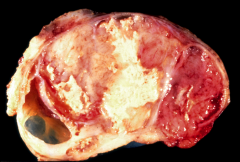
|
This surgical specimen illustrates the most common malignant ovarian tumor, namely serous cyst-adenocarcinoma. |
|

|
This woman has a pituitary adenoma that produces ACTH. She exhibits a buffalo hump, increased facial hair, and moon face. The diagnosis is Cushing disease. |
|
|
A 40-year old man had retro-sternal pain that was most pronounced when lying down after meals. This was associated with regurgitation of gastric acid into his mouth. What is the most likely cause of this condition? |
Acid reflux, sliding esophageal hernia |
|
|
A 60-year old man with a history of smoking and alcohol consumption could not swallow meat. What could account for dysphagia in this patient? |
Esophageal Cancer |
|
|
A 40-year old man complained of epigastric pain 3-4 hours after meals. He could pinpoint the most painful site on the anterior abdominal wall. What is the most likely diagnosis? |
Peptic ulcer disease |
|
|
A 20-year old woman complained of frequent bowel movements and bloody stools. Biopsy of the colon revealed ulceration of the superficial bowel mucosa. What is the most likely diagnosis? |
Ulcerative colitis |
|
|
A 60-year old man reported having thinned stools that were tinged with blood. What is a likely diagnosis? |
Colon carcinoma |
|
|
A 20-year old woman became jaundiced 3 weeks after vacationing in Mexico. She had no other symptoms. Could a viral infection be responsible for her condition? |
Yes, Hepatitis A |
|
|
A chronic alcoholic developed high fever, nausea and vomiting accompanied by jaundice after a 3-day drinking binge. What is the likely cause of acute hepatitis in this patient? |
Alcoholic hepatitis |
|
|
An obese, 45-year old woman developed spasmodic pain in the upper right quadrant of the abdomen 1 hour after ingesting a fat-laden meal. What is the most likely diagnosis? |
Gallstones, cholelithiasis |
|
|
Sudden enlargement of the liver was noted in a 50-year old man who was infected with hepatitis B virus during puberty and who developed signs of cirrhosis at the age of 40 years. The differential diagnosis included hepatocellular carcinoma. Which blood test should be ordered to substantiate the diagnosis of liver cancer in this patient? |
Alphafetoprotein |
|
|
Following 2 days of heavy drinking, a 40-year old man developed upper abdominal pain. You suspect acute pancreatitis. Which blood tests should you order? |
Lipase and amylase |
|
|
A chronic alcoholic had indigestion and bulky, foul-smelling fatty stools (steatorrhea). Radiographic examination of the abdomen revealed dystrophic calcification of the pancreas. What was the most likely cause of this condition? |
Chronic pancreatitis |
|
|
The mother of a 3-month old child palpated a mass on the left side of the child's abdomen. What is the most likely diagnosis for this mass? What would the diagnosis be if this mass were a neoplasm? |
Cystic renal dysplasia, neuroblastoma |
|
|
A 40-year old man has end-stage kidney failure and bilaterally enlarged kidneys. What is the most likely diagnosis? |
Autosomal dominant polycystic kidney disease |
|
|
A 4-year old child developed puffiness around the eyes and became chronically sleepy 2 weeks after an episode of "strep-throat." The mother noted that the child's urine was dark brown and was being excreted in small amounts. What is the most likely diagnosis? |
Post-infectious glomerulonephritis, Nephritic syndrome |
|
|
A 40-year old man noticed generalized swelling, most prominently in his face and lower extremities. His physician discovered proteinuria and hypoalbuminemia. What is the most likely cause of edema in this case? |
Nephrotic syndrome |
|
|
A 46-year old noticed brown-red urine and, over a period of 6 days, stopped urinating all together. What is the probable diagnosis? |
Acute renal failure |
|
|
A 50-year old man who underwent a routine medical check-up was found to have blood in his urine. X-ray studies revealed a renal mass on the left side. What is the probable cause of this hematuria? |
Renal Cell Carcinoma |
|
|
A 20-year old woman complained of pain during urination. She also noticed blood in her urine. What is the most likely diagnosis? |
Acute cystitis |
|
|
A 3-month old boy had a testis that was not palpable. What is the most likely diagnosis? |
Cryptorchidism |
|
|
A 1-year old boy had testis still in the inguinal canal. Why should an orchiopexy be performed? |
Increased risk of germ cell cancer and infertility |
|
|
A 60-year old man complained of urgency and dribbling on urination. What is the most likely diagnosis? |
Nodular prostatic hyperplasia (BPH) |
|
|
A testicular nodule was noticed by a 30-year old man on self-examination. What is the appropriate work-up for this painless nodule? |
Biopsy |
|
|
Elevated serum levels of prostate-specific antigen (PSA) were detected in a 60-year old man. What is the significance of these findings? |
This is a screening test for prostate cancer, but a single elevated PSA could indicate many things, including infection, hyperplasia, carcinoma, or even recent ejaculation. |
|
|
A 70-year old man with sclerosis of the lumbar vertebrae had a rock-hard prostate on palpation. Which serum enzyme tests should be expected to yield positive results? |
Prostate specific antigen (PSA), prostatic acid phosphatase, alkaline phosphatase |
|
|
A 35-year old woman received a report from her gynecologist indicating that she had a human papillomavirus (HPV) infection. This is important, because HPV is a risk factor for cancer of the: |
Cervix |
|
|
A 35-year old woman complained of heaviness in the abdomen and frequent urge to urinate. Gynecologic examination revealed an enlarge, bulky uterus. What is the probable diagnosis? |
Uterine fibroids, leiomyomas |
|
|
A 28-year old woman had vague lower abdominal pain that intensified at the time of menstruation. What is the possible cause of this pain? |
Endometriosis |
|
|
A postmenopausal 52-year old woman who had cessation of menstruation suddenly noted a bloody vaginal discharge. Pap smear was normal, but endometrial biopsy revealed a malignancy. The most appropriate histological diagnoses is: |
Endometrial adenocarcinoma |
|
|
A 70-year old woman noted abdominal swelling. The doctor diagnosed ascites and requested a gynecologic consultation. What findings might be expected on gynecologic examination? |
Ovarian Cancer |
|
|
A 30-year old woman stopped menstruating and developed chest hair. Such virilization could be caused by: |
Could be polycystic ovary syndrome, but could be caused by many other conditions, including Cushing disease and certain ovarian tumors |
|
|
A pregnant woman presented to an emergency room 5 months after her last menstrual period complaining of spotting. An enlarged uterus, corresponding to a 7-month pregnancy was noted. No fetal movement was evident. What is the most likely diagnosis? |
Hydatidiform Mole, Molar pregnancy |
|
|
A 3-cm breast mass was found in a 20-year old woman. What is the most likely diagnosis? |
Fibroadenoma |
|
|
Painful, small nodules in both breasts were noted in a 40-year old woman. What is the most likely diagnosis? |
Fibrocystic change of the breast |
|
|
A 3-cm mass was palpated in the breast of a 55-year old woman. What is the most likely diagnosis? |
Invasive ductal carcinoma |
|
|
A 30 year-old woman who is not pregnant has not menstruated for 4 months and is now producing milk from her breasts. What is the diagnosis? |
Pituitary adenoma (prolactinoma) |
|
|
A 40-year old man noticed enlargement of his feet (suddenly ill-fitting shoes) and hands. He had prominent lower jaw and noticed that his teeth were becoming separated from one another. What is the name for this endocrine disorder? What could have caused these symptoms? |
Pituitary adenoma |
|
|
A 45-year old woman presented with complaints of sweating a lot, feeling hot and being constantly tired. She had a fast pulse rate and reported feeling constantly hungry. On examination, she was found to have bulging eyes and enlarged thyroid. What is the diagnosis? |
Grave's disease |
|
|
What is the pathogenesis of Grave's disease? |
Autoimmune disease with anti-TSH receptor antibodies |
|
|
A 30-year old woman noted a "swelling" on the anterior side of her lower neck. She had no other symptoms. What is the most likely diagnosis? |
Goiter |
|
|
A 50-year old man became extremely obese, with fat accumulating most markedly on his trunk. He had a red rounded face and almost translucent skin that was prone to bruising. What is the first question that should be posed to this man? |
Are you taking steroids? Cushing syndrome |
|
|
A 40-year old man reported having sudden attacks of dizziness, blurred vision, and excruciating headaches. During these attacks his blood pressure was 180/120 mmHg. What could cause these paroxysms of hypertension? |
Pheochromocytoma |
|
|
A 20-year old woman presented with a history of weight loss and urinary frequency (polyuria). She reportedly ate a lot and was always thirsty? What is the most likely diagnosis? |
Diabetes mellitus type 1 |
|
|
The development of diabetic complications (e.g. atherosclerosis, renal failure and blindness) relates largely to the severity and chronicity of: |
Hyperglycemia |
|
|
A baby born with a small skin defect on her lower back could not move her legs. What is the most likely cause of her congenital paralysis? What is the blood test that is used for prenatal diagnosis of this disease? |
; Alpha-fetoprotein |
|
|
A 60-year old man with hypertension suddenly developed an excruciating headache, collapsed, and became unconscious. What is the cause of this man's collapse? |
Hemorrhagic Stroke |
|
|
A 20-year old woman had a car accident. When she was removed from her car, she could not move her legs. One month later she is still unable to move her legs. Is she paralyzed for life? |
Yes |
|
|
A 50-year old woman with a respiratory infection developed severe headache, fever, vomiting, blurry vision, and neck rigidity. What is the most likely cause of these symptoms? |
Meningitis |
|
|
The family of a 70-year old man noticed that he had become very forgetful. He could not remember anything and was dismissed from his office job. What is the most likely diagnosis? |
Senility, but could be Alzheimer disease |
|
|
Spongiform encephalopathies are a group of neurodegenerative diseases characterized by slowly progressive ataxia and dementia. The infectious agents of these diseases (prions) are best defined as: |
Abnormally folded proteins |
|
|
Elderly woman with acute abdominal pain A 67-year-old woman complains of acute diarrhea and severe abdominal pain. She was recently treated with broad-spectrum antibiotics for community-acquired pneumonia. A CBC shows an elevated WBC count. The patient subsequently develops septic shock and dies. Examination of the rectosigmoid region of colon at autopsy reveals raised, yellowish plaques that adhere to the underlying mucosa. These findings are typical of which of the following gastrointestinal diseases? The most likely diagnosis is: |
Pseudomembranous colitis |
|
|
Chronic alcoholic with "acute abdomen" A 40-year old male, obese, chronic alcoholic was admitted to TJU Hospital with a diagnosis of "acute abdomen". Severe pain and tenderness started after a large meal, which included a considerable amount of alcohol. The pain radiated over the entire abdomen into the back. Physical examination revealed a pulse rate of 120/minute. The blood pressure was 90/50 mm Hg. He was wheezing, in apparent respiratory distress, and extremely apprehensive. The anterior abdominal wall was rigid and very tender to palpation. Laboratory findings included increased amylase and lipase in the serum. The following day, low serum calcium and glucosuria were found. The patient was treated for shock, but this was unsuccessful. The patient died on the third day of hospitalization. The most likely diagnosis is: |
Acute pancreatitis |
|
|
Elderly man with hematuria A 60-year old man presented with hematuria. Physical examination revealed an obese individual with moon facies. The patient was suffering from extreme left flank pain. Blood work-up revealed marked erythrocytosis and hyperglycemia. A CT scan was performed and revealed a solid 3cm x 3cm mass in the left kidney. An angiogram demonstrated that the mass is highly vascular. A fine-needle aspiration of the tumor established the diagnosis and the patient received a radical nephrectomy. The most likely diagnosis is: |
Renal Cell Carcinoma |
|
|
Pregnant woman with vaginal bleeding A 28-year old woman, 28 weeks pregnant, sought medical attention when she first experienced vaginal bleeding. She did not have a history of uterine contractions. Physical examination revealed a well-developed, obviously pregnant woman in no acute distress, with active oozing of blood from the vaginal outlet. Pelvic examination revealed a large, exophytic mass on the left side of the cervix. Bright red blood was present in the endocervical canal. Radiologic examination demonstrated a 5 cm mass involving the endocervix and ectocervix. There was no evidence of direct tumor extension into the parametrium. The pelvic lymph nodes were slightly enlarged, raising the possibility of nodal involvement by a tumor. A radical hysterectomy was performed, following the delivery of a healthy baby by C-section at 31 weeks gestation. The most likely diagnosis is: |
Cervical Squamous Cell Carcinoma |
|
|
Woman with deepening voice and headaches A 30-year old woman complained of headaches, disturbances of vision, deepening of the voice and generalized weakness. She had amenorrhea for the past year. Although her family had not noticed it, she believed her facial features had changed - becoming somewhat coarse with thickening of the facial folds and furrowing of the brow. Upon questioning, she stated that she recently required a larger shoe size. Laboratory studies revealed hypercalcemia and impaired glucose tolerance. Plasma growth hormone levels were also elevated. The most likely diagnosis is: |
Acromegaly |
|
|
Woman with impaired balance when walking A 30-year old woman had been well until recently when, following a flu-like illness, she developed a tremor of her arms and impaired balance when standing or walking. Other studies failed to disclose any abnormalities. These symptoms lasted a week, but then she recovered. Eighteen months latter, she experienced another episode of weakness and required assistance when walking. At this time she also complained of blurred vision. She was referred to a neurologist who found ataxia, dysarthria, decreased vibratory sensation in her legs, absent abdominal reflexes, increased deep tendon reflexes, and a Babinski sign on the left. Subsequently her illness was characterized by remissions and exacerbations, but overall was slowly progressive. She became bedridden 15 years after the onset of the disease, and she developed a neurogenic bladder. She was subsequently rehospitalized with a high fever and died of sepsis. The most likely diagnosis is: |
Multiple Sclerosis |
|
|
Achalasia
|
Absence of peristalsis in the body of the esophagus and failure of the lower esophageal sphincter to relax in response to swallowing |
|
|
Barrett esophagus |
Columnar metaplasia of the esophageal squamous epithelium in response to chronicgastro-esophageal reflux |
|
|
Tracheoesophageal fistula |
Communication between the trachea and esophagus |
|
|
The large majority of cancers of the esophagus are histologically classified as: |
|
|
|
|
The most common cause of chronic (non-erosive) gastritis. It is also an importantfactor in the pathogenesis of peptic ulcer disease. |
|
|
|
A disease that is typically found in the distal stomach and proximal duodenum |
|
|
Name an inflammatory bowel disease in which the mucosal surface of the colon iscovered by irregular plaques composed of necrotic debris and an acute inflammatoryexudate. Clostridium difficile is the offending organism. |
|
|
|
The mucosal (inner) surface of the large bowel exhibits a distinct "cobblestone"appearance and microscopic examination reveals ulcers and transmural inflammationwith granulomas. The most appropriate diagnosis is: |
|
|
|
Most carcinomas of the colon are believed to arise in preexisting lesions. Name theselesions. |
|
|
|
Name an autosomal dominant trait which inevitably leads to carcinoma of the colon byage 40 unless a total colectomy is performed. |
Familial adenomatous polyposis |
|
|
A patient in hepatic failure displays yellow skin and sclera. This condition, associatedwith high levels of circulating bilirubin, is referred to as: |
|

